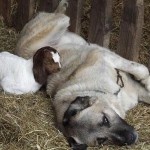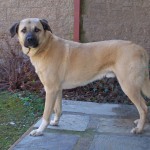 I am writing to try to help people understand the Anatolian Shepherd Dog by understanding his history, the nomadic life of his people, and the job that he has been bred to do under those conditions. A thorough understanding of the dog and the job he is supposed to do gives you a thorough understanding of his behavior. Understanding the background and the dog’s behavior, his reactions to situations are quite predictable.
I am writing to try to help people understand the Anatolian Shepherd Dog by understanding his history, the nomadic life of his people, and the job that he has been bred to do under those conditions. A thorough understanding of the dog and the job he is supposed to do gives you a thorough understanding of his behavior. Understanding the background and the dog’s behavior, his reactions to situations are quite predictable.
Origins of the Livestock Protection Dog
Archaeology, anthropology, sociology, and geography students of the mideast, central-mid-Asia, and lower European Mediterranean cultures can demonstrate the results and effects of nomadic peoples’ movements from Pakistan, central Asia, Turkey, and the Turkey-bordering republics of lower Russia across lower European/Mediterranean-bordering countries to the westernmost borders of Spain and Portugal, from the earliest civilizations in the mideast through present times and today’s diverse cultures. These nomadic peoples were and are the meat producing people that have lived and moved with their flocks while seeking food for their animals.
- They live on the fringes of the farmable crop-producing land used by settled people that are content to live in one area and produce grain and vegetable foods for generations.
- Meat producing livestock people must have large areas of grazing land for their animals.
- Livestock producing people, always in search of pasturage, must be a nomadic people. Grazing land is weather controlled by seasonal extremes-i.e., winter snows, rainy seasons, great floods, seasonal droughts, and years of total dearth of moisture-that require livestock producing people to move livestock and their families frequently, efficiently and safely.
- The greatest constant need of a nomadic people is for all-encompassing, consistent, capable, efficient protection that is as mobile as the society it is a part of.
The earliest nomadic people soon realized that there was one very capable predator animal that would, if it was well fed by the people, live near them and drive off all other predators. It would, in effect, instinctively protect the food supply for all by protecting the easy source of its own food. The predators also lived in and worked as groups and seemed drawn to the group existence of the nomads and their livestock.
Thus was the shepherd dog-a dog found with the shepherds and now labeled the Livestock Protection Dog-developed.
Mobile livestock producing societies cannot support non-working members.Older men and young boys unable to do men’s work were the shepherds that took the livestock out of their nighttime protection compounds and moved them to their daytime grazing areas. The dog was not needed to help with this movement of livestock. The dog’s instinct was to protect its food supply, so the dog always accompanied the livestock and shepherds as they went out for the day’s grazing. It stayed out with the flocks and returned with them in the evening.
These dogs worked as groups, and certain members of the group would elect to stay in the encampment during the day to protect their food supply in the camp. It is noteworthy that, in those societies where the dogs still are used today, it is not always the same dogs that elect to go out or stay. Frequent coming and going of the dogs, especially the younger ones, between groups and to and from camp, can be observed. Ray Coppinger and Jay Lorenz, on their New England Farm Center study (early 1980s), documented this in one of their reports. They initially had attempted to stay with a village group and study the different behaviors of individual dogs. In camp at night, they had no problem keeping track of individual dogs. During the day, when they went out with the shepherds and a group of dogs, they had no way of studying an individual dog, as the composition of the group kept changing. The shepherds said this was normal behavior. Also noted was the fact that none of the grazing groups-nor the camp inhabitants, women, children, and assorted small animals and fowl-was ever left without a sufficient number of dogs for protection.
With their guaranteed food source, these early shepherd dogs soon started multiplying rapidly. Larger litters of pups came and survived into adult dogs, instead of only one or two of a litter surviving as might occur with haphazard food supplies. Shepherds quickly learned to recognize the outstanding behaviors of a select few dogs. At around 5 or 6 months of age, the shepherds knew which of the pups had potentially the best behaviors and soundest structures that they needed for the best adult dog protector. Lesser behaviors and structures had to be disposed of. They could not be allowed to go back into the wild and become predators again. Selective culling for the most outstanding dogs-to be saved and maintained as breeding stock-has been practiced from those early days and still is practiced today by these users of protection dogs.
Characteristics of the Livestock Protection Dog
These are the paramount structures, behaviors, and dispositions a shepherd requires in a capable guarding dog.
1. STRUCTURE: The shepherd requires a dog with a body structure that maximizes the full range of motion in the dog’s shoulders and hips, allowing a free, full single-track gait and making the dog capable of sudden bursts of great speed from a prone (or any other) position. The dogs must have the agility to leap, twist, turn in mid-air, land and take off in the opposite direction without missing a stride. In extreme circumstances, they must land on a predator, dispatch it and continue on to a companion predator, again with no loss of momentum.
The dogs must have the endurance to travel great distances with little water and/or food when necessary. Their coats must be sufficient to maintain normal body temperatures whether in severe winters in mountain areas or on a hot desert trek. They need appetite control mechanisms, so they only eat the quantity of food needed to supply sufficient energy for the day’s activities. This prevents excessive weight gain and dogs that are too fat or heavy to be the agile animals they must be for the protective work they do.
There is, or may be, great diversity in body structures, even within a litter. This is due to the travels of nomadic peoples from mountain to desert regions. Dogs in higher mountain type environments need heavier bodies that will maintain warmth in winter temperatures. Desert dogs need to have lighter structures that allow maximum cooling and long distance movements. During nomadic moves, the dogs mixed and matched with those in the local populations (products of previous nomadic groups), and the shepherds always “kept the best.”
2. BEHAVIOR: The dog must have behaviors that allow it to quickly identify normal livestock and camp activities and behaviors among the individual and group members. It has to constantly assess situations as environments and seasons change. The dog must know the difference between a real threat and an unusual behavior. The dog’s only instinct is to protect living things belonging within the set perimeters where the group lives or occupies during a move.
The dog is to attempt to discourage or “scare off” all possible threatening creatures with as little activity as possible on his part. He is not to frighten nor unduly alarm the subjects he is accompanying and protecting.
If physical intervention is required, the dog is to first discourage or disarm the attacker so it will flee. The attacker that continues the attack is to be quickly, quietly, and efficiently dispatched. The dog uses several behaviors to accomplish its job.
- The dog signals its charges that there is something unusual out in the nearby area. It is not a threat-and he is watching. This is a “no problem” bark-just telling you bark.
- “Be alert” bark. Unusual object approaching. I am watching, will keep you informed.
- Group together, move where my tail is pointing. “Do not be alarmed, I have the situation under control” bark.
- Growl/warning bark to the approaching object: “Stop or I will stop you.”
This bark also tells the owner of the dog, “You’d better see what is happening. Someone or something is going to be attacked by your dog if you don’t stop him.” This does not really mean that the dog will bite. It does mean that the dog is going to use force to stop the approach. Frequently, the dog just knocks the figure down and stands on it; it may knock a person into a wall or fence, etc. and hold them there until the boss arrives and takes over.
The adult livestock protection dog has a CONTROLLED BITE. He bites only hard enough to ensure compliance with his “STOP” command. The Anatolian’s instinct is to stop the advance of the attacker, to discourage or subdue it as necessary, so it will run away when it is allowed to get up. In extreme incidents, when the dog is sure the intruder will not be deterred and is an actual life threat to its charges, the Anatolian can be lethal quickly, efficiently, and silently, with as little disturbance to its protected charges as possible.
The Anatolian otherwise, especially in camp, is to be non-frightening, non-aggressive, non-threatening, non-injuring, and extremely tolerant of all living things in its domain.
3. DISPOSITION: By vision, hearing, and scent, the Anatolian can identify all of the inhabitants of his territory and their usual activity and, for the most part, he can predict what the inhabitants are going to do next.
Specific sights and sounds accompany and identify specific activity. The Anatolian response to these “usual” activities depends on his activity level at the time. When he knows what is going on, or what is going to occur, the Anatolian may or may not get up and participate. Frequently he may just sit and observe from where he is.
The dog is to be observant of any unusual disturbance but should not join in unless his “charges” are threatened. The dog is to be tolerant of non-threatening passers-by, two-legged or four-legged. Whenever there is a direct threat involved, then he will be out in the front of any activity.
The Anatolian is a team companion protector with you. The Anatolian is NOT YOUR SLAVE. IT WILL NOT WORK ON COMMAND.
The Anatolian will not respond to a human-directed, practiced, learned command. The behavior it responds to comes from centuries of developed companion protection instincts. It learns what the usual, normal, allowable activities and actions of community members are. It understands that emotional, erratic, irrational, undisciplined, undependable activities are to be discouraged but not to destroy the actor. It recognizes the behavior of ill, injured companions. It will give extra support and comfort and protection to them. Individual Anatolians accept modification of these instincts, by the pack leader, to fit specific situations.
I have attempted to identify and describe the adult Anatolian. It will take two to two and one-half years of observation, attention, and consistent correction by the adult pack leader members before they have the companion protector they want the dog to be. Adult human family owners must give the same constant, consistent attention and correction to a pup that adult dog pack leaders give to the young growing members of their animal pack. In pack animals, the entire adult community is usually responsible for rearing the young, not just mom and dad.
This article is reprinted from Choban Chatter, vol. 6, no. 1 (summer 1996)


